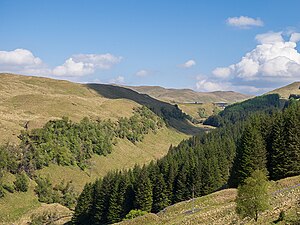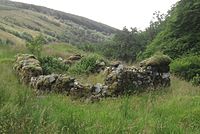Glen Shira
Glen Shira is a glen in Argyllshire at the northern end of Loch Fyne, just to the north of Inveraray. It uis named after the River Shira, which has carved this glen through the hills. The name of the river has been interpreted as from the Gaelic Siara meaning 'Eternal river'.
The river starts in north-east at about 1,150 feet above sea level, near the start of the River Fyne. The river is not left in natural peace but runs into the 5 MW Sron Mor power station dam. Below the power plant, it flows for about seven miles down to and through Loch Dubh (Black Lake) at the base. From there, the waters flow into Loch Shira, a small inlet on Loch Fyne that, in turn, lends its name to the MV Loch Shira ferry.
The glen is a 'Special Area of Conservation', bordered by Beinn Bhuidhe on the Glen Fyne side.
The glen is mostly taken up by a resident's sheep farm, but there are numerous houses within the glen, including Elrigbeg (Eileirig Beag), Elrig More (Eileirig Mór), Kilblaan and Drimlee (at the northern end). There is one single-track road which leads up the glen to the dam. This road splits into an access road (connected across the River Shira by a bridge) which leads to Drimlee.
Rob Roy MacGregor, the outlaw, lived in Glen Shira for a short time under the protection of John Campbell, 2nd Duke of Argyll, also known as Red John of the Battles (Iain Ruaidh nan Cath). Argyll negotiated an amnesty and protection for Rob in 1716, and granted him permission to build a house in upper Glen Shira after disarmament. Records suggest that Rob Roy also constructed a fank for sheep or cattle in the Glen. However, some time after the 1719 Jacobite Rebellion — likely around 1720 — Rob moved to Monachyle Tuarach by Loch Doine, abandoning the structures. Nevertheless, ruins remain extant.
Location
- Location map: 56°17’6"N, 5°1’1"W
References
- Renton Family, Glen Shira
- W.H. Murray, Rob Roy MacGregor, His Life and Times, Conongate Books Ltd., 3rd ed. (1996).


